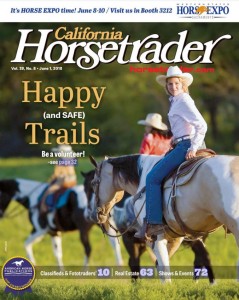 SAN MARCOS — If you drove past the Walnut Grove Equestrian Park arena on a recent Saturday about lunchtime, you may have seen the mayhem.
SAN MARCOS — If you drove past the Walnut Grove Equestrian Park arena on a recent Saturday about lunchtime, you may have seen the mayhem.
There were loud protesters shoving signs at 15 people on horseback, including some kids. There were smoke bombs, loud music, and some large, strange-looking beings.
But all was OK. The riders also had complete control — with the help of Mo Parga.
Parga, a San Diego native who retired last month after nearly 33 years in the San Diego Police Department, was one of the clinicians at the City of San Marcos Day of the Horse May 20 in one of the county’s only municipal equestrian facilities. For years, Parga headed the now-disbanded mounted unit with the SDPD, but her passion for horses, community and volunteerism has spawned a new chapter — helping to form, train and coach volunteer patrols for local community trails.
“I have a love for the volunteers, and if I can help promote more volunteer mounted trail groups, I’ll be happy,” says Parga, who lives in El Cajon with her husband, a retired narcotics sergeant on the SDPD, and their horses. “The trail volunteers are good PR and eyes and ears for the rangers — not enforcement. San Marcos is going to have some eyes and ears for the rangers on the horses.”
Safety on the trail is paramount, Parga insists, and simply attending her training is no guarantee of certification — although she invites anyone who isn’t certified to continue learning. Her clinics are limited to 15, and she has a minimum of four ground crew team-members engaged with each class. She says no one has been injured in 15 years of her clinics, which are designed to help horses understand the humans that get on their backs.
“My goal is to promote safety and calmness while they are riding,” says Parga, who always wears her helmet during instruction. “In the sensory training, they can see and learn along with their horse. The horse gets to trust the rider that they are not going to get hurt. In turn, the rider learns to trust the horse and feeds off the horse giving them confidence.
“It’s about them working together as a team so that the horse won’t spook on the trail and has trust in the rider, which is huge.”
Students come to these sensory trainings expecting to encounter situations never before experienced — but that could happen on public trails.
“The rider comes way with a ‘whoa — my horse was able to do this!’, and ‘I got him through the gauntlet — and my horse now trusts me!’,” Parga adds. “If they come away going ‘hey, my horse is really good!’, then we just built this trust and confidence in each other — that they can go out on the trail and handle the horse and their riding ability.”
Some riders have entered the arena and informed her that they have never cantered their horse.
“They limited themselves because they didn’t think they could do the sensory training of a mounted patrol officer, so the training gives them a taste of what it’s like to be a mounted patrol officer and how they handle their horses,” Parga says. “If they come away safer and also with a better bond between themselves and their horse, that’s the main goal,” she says. “They’ve really learned how to control a horse when it did get upset.”
Parga says the first step to establishing a volunteer mounted patrol in a community is to reach out to the civic organization and get its blessing. She can then work together with the municipality and the volunteers with the process. Once established, the group can get her assistance with affordable group sessions like the one last month in San Marcos, evaluating the suitability of horses as well as undergoing the exercises.
MORE ONLINE: http://bit.ly/06_Trails
.
Leave a Comment
All fields must be filled in to leave a message.